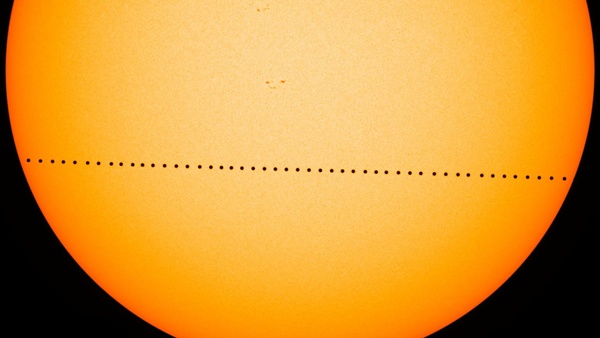The Sky This Week from November 8 to 17 – Astronomy Magazine
Mercury transits the Sun
NASA’s Solar Dynamics Observatory captured Mercury transiting the solar disk May 9, 2016. The innermost planet gives a repeat performance November 11.
NASA/GSFC/SDO/Genna Duberstein
Mercury passes directly between the Sun and Earth today for the first time since May 9, 2016. The innermost planet’s dark disk will cross the Sun’s face for 5.5 hours. Observers across most of North and South America, Europe, and Africa can view at least some of this transit. This is a morning event for most North Americans. Mercury first touches the solar disk at 7:35 a.m. EST, lies closest to the Sun’s center at 10:20 a.m., and leaves our star’s limb at 1:04 p.m. You’ll need a telescope equipped with a safe, full-aperture solar filter to see this event. For complete viewing details, see “Observe the transit of Mercury” in the November issue of Astronomy. If you miss this event, you’ll have to wait until November 2032 to see another; the next one visible from North America won’t occur until May 2049.
Full Moon officially arrives at 8:34 a.m. EST tomorrow morning, but it will look completely illuminated both tonight and tomorrow night. You can find it rising in the eastern sky around sunset and then watch it climb highest in the south by midnight local time. It dips low in the west by the time morning twilight starts to paint the sky. The Moon lies against the backdrop of southern Aries tonight. By tomorrow evening, it will appear among the background stars of Taurus the Bull, west of the Hyades star cluster and south of the Pleiades.
Tuesday, November 12
This morning provides a nice opportunity to spot Mars near the beginning of its 20-month-long apparition. If you look low in the east-southeast about an hour before the Sun rises, the first object you’ll see is 1st-magnitude Spica, Virgo the Maiden’s brightest star. Look more closely and you should notice Mars’ ruddy glow just 3° to its left. Shining at magnitude 1.8, the planet appears half as bright as the star. Mars will grow more conspicuous over the coming months as it approaches a spectacular opposition in October 2020.
Wednesday, November 13
Saturn remains a glorious sight this week. The ringed planet resides among the background stars of Sagittarius the Archer, a region that appears 20° high in the southwest as twilight fades to darkness and doesn’t set until after 8 p.m. local time. Saturn shines at magnitude 0.6 and appears significantly brighter than any of its host constellation’s stars. Although a naked-eye view of the planet is nice, seeing it through a telescope truly inspires. Even a small instrument shows the distant world’s 16″-diameter disk and spectacular ring system, which spans 36″ and tilts 25° to our line of sight.
Thursday, November 14
As Venus inches higher with each passing day, it appears to be on a collision course with Jupiter. Although Jupiter shines two magnitudes fainter than Venus, the magnitude –1.9 gas giant world is still the night sky’s second-brightest point of light. This evening, the two planets stand 10° apart — about the span of your closed fist when held at arm’s length. The gap will narrow by 1° per day, setting up a dramatic conjunction late next week. If you point a telescope at Jupiter this week, you’ll see a 33″-diameter disk with striking details in its dynamic atmosphere.
Friday, November 15
Look high in the southeast after darkness falls this week, and you should see autumn’s most conspicuous star group. The Great Square of Pegasus stands out in the evening sky at this time of year, though it appears balanced on one corner and looks more diamond-shaped. These four almost equally bright stars form the body of Pegasus the Winged Horse. The fainter stars that represent the rest of this constellation’s shape trail off to the square’s west.






